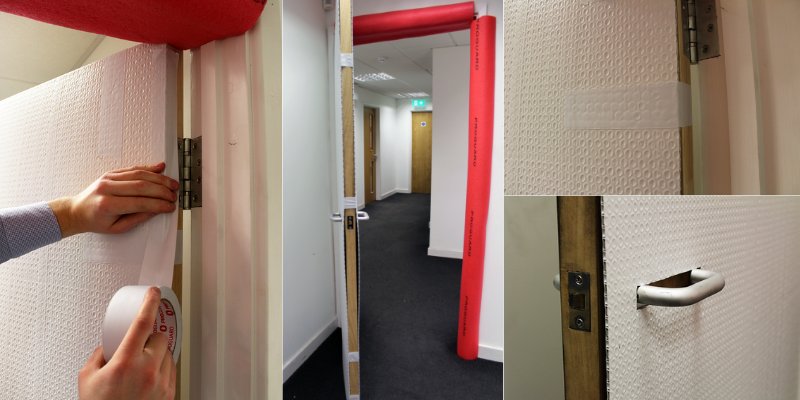
In the chaos of renovations—whether you’re tearing down walls or updating fixtures—door latches can take a beating. Dust, debris, paint splatters, and even heavy impacts can damage them. So, how can you keep your door latch safe and sound? Let’s dive into some effective ways to protect it during your home improvement journey.
Why Protecting Your Door Latch Matters
You might be wondering, “Why bother with a latch?” Well, think of your door latch as a vital part of your home’s security system. It not only keeps your door closed but also helps maintain your home’s insulation and privacy. If a latch gets damaged during renovations, it could lead to more significant security issues, or worse, a door that won’t close properly.
Renovations can stir up a whirlwind of activity, including dust, heavy tools, and eager workers. The last thing you want is to have a broken latch or one that doesn’t work smoothly after all the hard work you’ve put in. A little precaution can go a long way in saving you from future headaches.
Remove the Latch Temporarily
One of the best ways to protect a door latch during renovation is to remove it entirely. This might sound like a bit of work, but trust me; it’s worth it. Here’s a step-by-step approach to doing this:
- Gather Your Tools: You’ll need a screwdriver, a small container for screws, and possibly a wrench, depending on your latch type.
- Take It Off: Carefully unscrew the latch from the door and frame. Don’t forget to place the screws in your container so they don’t get lost!
- Store It Safely: Keep the latch in a safe spot away from dust and debris. You might even wrap it in a cloth to prevent scratches.
By removing the latch, you not only protect it from damage but also give yourself a chance to clean the area thoroughly before reinstallation.
Covering the Latch with Tape
If removing the latch isn’t an option, covering it securely can be a great alternative. Here’s how:
- Choose the Right Tape: Use painter’s tape or masking tape, as they won’t leave a sticky residue behind.
- Apply the Tape: Cover the latch thoroughly, ensuring that all parts are shielded from dust and paint.
- Seal the Edges: Press down firmly on the edges to ensure no dust or dirt can sneak in.
This simple approach can keep your door latch neat and tidy, while still allowing easy access for when you’re ready to reinstall or unseal it.
Use Drop Cloths or Plastic Sheeting
During renovations, protecting everything around you becomes essential. Drop cloths or plastic sheeting can be incredibly helpful.
- Cover Doorways: Drape drop cloths over doorways or use plastic sheeting to create a barrier between the work area and your door latch.
- Weight Them Down: Use furniture or weights to keep the cloths in place; this prevents them from blowing around and exposing your latch to dust.
- Check Often: Make sure to adjust as needed during the renovation process to keep everything covered.
This method not only keeps your door latch safe but also protects your floors and walls from renovation mishaps.
Be Mindful of Heavy Equipment and Tools
It’s easy to forget about how much impact tools can have during renovations. Heavy equipment can knock against your door, leading to accidental damage to your latch.
- Plan Equipment Placement: Keep tools and equipment away from doorways when setting up your workspace. This minimizes the risk of accidental bumps.
- Use Temporary Barriers: If possible, create a physical barrier around the door by using furniture or other materials to guard it.
- Communicate: If you have workers helping out, make sure they know to be cautious around doors and latches.
This conscious effort can save you a lot of stress and repairs down the line.
Cleaning After the Renovation
Once the renovation dust settles, it’s time to clean up. A thorough cleaning is crucial for maintaining the functionality of your door latch.
- Remove Dust: Use a soft, dry cloth to gently wipe down the latch and surrounding door frame.
- Avoid Harsh Chemicals: Stick to simple cleaning solutions to prevent damage to the latch’s finish.
- Lubricate: After cleaning, apply a little lubricant to the latch mechanism to ensure smooth operation.
By taking the time to clean properly, you can ensure that your door latch is not only protected but also works efficiently.
Consider Upgrading Your Latch
If your latch has seen better days or you’re still worried about damage, it might be worth considering an upgrade. A new latch can provide better security and functionality.
- Choose Durable Materials: Look for latches made from strong materials like stainless steel or brass.
- Research Options: Check out various modern designs that might even offer additional features, such as keyless entry or smart technology.
- Consult a Professional: If you’re unsure about what to choose, talking to a locksmith or home improvement expert can prove helpful.
Investing in a new latch can be a smart move, ultimately saving you from future headaches.
Final Thoughts on Door Latch Protection
Protecting your door latch during renovations is a straightforward yet important task. Taking time to remove it, cover it, or create barriers can ensure that it remains functional and secure. By being mindful of your surroundings and planning ahead, you can avoid any unnecessary damage.
Renovations are exciting, but they can be chaotic. Keeping your door latch in top condition is just one small step in ensuring that your home remains a safe and welcoming space. With just a little bit of care, your latches will be ready to serve you well for many years to come.